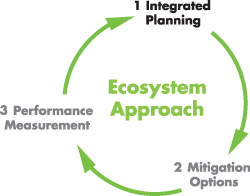Eco-Logical: An Ecosystem Approach to
Developing Infrastructure Projects
I. Advantages of an Ecosystem Approach

Eco-Logical suggests a method for achieving an ecosystem approach that expects agencies to work together, and with the public, to integrate their respective plans to determine environmental priority areas. With priorities understood, mitigation options can be explored where impacts are unavoidable. The performance of implemented mitigation can then be measured, providing information useful to future iterations of the integrated planning process.
An ecosystem approach is a method for sustaining or restoring ecological systems and their functions and values. It is goal driven and is based on a collaboratively developed vision of desired future conditions that integrates ecological, economic, and social factors. It is applied within a geographic framework defined primarily by ecological boundaries.
Over the last several decades, an understanding of how infrastructure - the basic facilities needed for the functioning of a community or society - can negatively impact habitat and ecosystems has grown. Awareness of how to better avoid, minimize, and mitigate these impacts has also matured. Regarding the latter, mitigation of project impacts has commonly been focused on replacing similar resources as close to the impact site as feasible. This approach generally focuses on satisfying regulatory requirements, but may not be serving the highest ecological needs in a given area.
Within an ecosystem approach, the context of a particular infrastructure project(s) and the partners implementing it determine the ecosystem's boundaries. For this reason, an ecosystem approach can help move agencies from being confined to project boundaries and regulatory checklists to addressing permitting predictability and habitat conservation on broader, ecosystem scales. An ecosystem approach can allow for more efficient and cost-effective ways to avoid and minimize impacts. It can also help to identify and capitalize on opportunities for meaningful mitigation and conservation—opportunities that may be quickly disappearing or becoming too expensive to realize as areas of ecological importance are developed.
Federal Agencies Support an Ecosystem Approach
In December of 1995, the Council on Environmental Quality (CEQ) and the agencies jointly publishing this document signed an interagency Memorandum of Understanding (MOU) encouraging an ecosystem approach. The MOU articulated a policy that the "Federal Government should provide leadership in and cooperate with activities that foster the ecosystem approach to natural resource management, protection, and assistance. Federal agencies should ensure that they utilize their authorities in a way that facilitates, and does not pose barriers to the ecosystem approach." It also emphasized "forming partnerships between Federal, State, and local governments, tribes, landowners, foreign governments, international organizations, and other stakeholders." The MOU provides a starting point for the encouragement and direction that Eco-logical offers. See Appendix A for the complete MOU.
All Benefit
Together, partners can work to implement an ecosystem approach to infrastructure projects. In doing so, substantive contributions to species, watershed, and ecosystem health and recovery can be made that are sometimes missed when regulations are administered on a project-by-project basis. Although the approach can have significant and tangible benefits to the environment and the public, and has the potential for improved interagency coordination, it cannot completely eliminate conflict. Instead, an ecosystem approach should be viewed as a tool for partners to develop acceptable solutions that complement agency missions.
Some of the other mutual benefits of an ecosystem approach to infrastructure projects include:
- Safer, improved infrastructure - All agencies and stakeholders contribute to the delivery of infrastructure. The collective abilities and knowledge shared within an ecosystem approach should allow a more balanced understanding of ecological and social concerns.
- Improved watershed and ecosystem health - A systematic approach to the preventive, diagnostic, and prognostic aspects of ecosystem management, and to the understanding of relationships between ecological issues and human activities.
- Increased connectivity and conservation - Since an ecosystem approach to infrastructure projects takes a broad view of interacting human and natural systems, it can help agencies plan and design infrastructure in ways that minimize habitat fragmentation and protect larger scale, multi-resource ecosystems.
- Efficient project development - Uncertainty during project development imposes a high cost on agencies and partners, in both time and money. An ecosystem approach fosters cost-effective environmental solutions that can be incorporated early in the planning and design of infrastructure projects.
- Increased transparency - Infrastructure projects developed with an ecosystem approach provide opportunities for and encourage public and stakeholder involvement at all key stages of planning and development.

